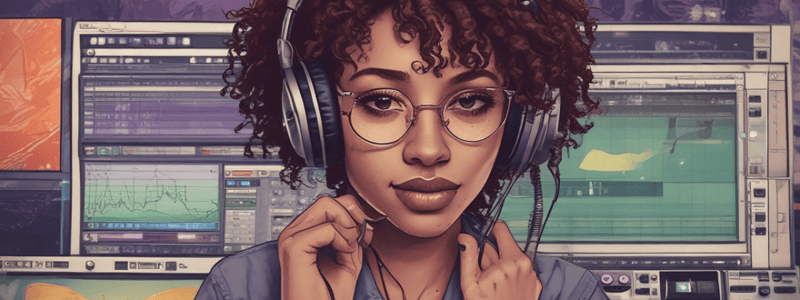Podcast
Questions and Answers
What is the primary function of Slip mode in Pro Tools?
What is the primary function of Slip mode in Pro Tools?
- To enable precise clip placement
- To constrain edits to a specific grid value
- To allow for free editing without any constraints (correct)
- To move clips to butt up against each other
What happens when a clip is deleted in Shuffle mode?
What happens when a clip is deleted in Shuffle mode?
- The gap remains open
- The adjacent clips move freely
- The clip reappears at a new location
- The gap closes up (correct)
How can you temporarily override the current edit mode?
How can you temporarily override the current edit mode?
- By holding the Shift key
- By holding the Command key (Mac) or Control key (Windows) (correct)
- By selecting a new edit mode from the toolbar
- By right-clicking on a clip
What is the purpose of Spot mode in Pro Tools?
What is the purpose of Spot mode in Pro Tools?
How many edit modes are available in Pro Tools?
How many edit modes are available in Pro Tools?
What is a characteristic of Slip mode in Pro Tools?
What is a characteristic of Slip mode in Pro Tools?
What happens to adjacent clips when a clip is positioned between them in Shuffle mode?
What happens to adjacent clips when a clip is positioned between them in Shuffle mode?
What is a characteristic of Grid mode in Pro Tools?
What is a characteristic of Grid mode in Pro Tools?
What is a characteristic of Relative Grid mode in Pro Tools?
What is a characteristic of Relative Grid mode in Pro Tools?
Flashcards are hidden until you start studying
Study Notes
Pro Tools Edit Modes
- There are four edit modes in Pro Tools: Shuffle, Slip, Spot, and Grid.
- These modes can be selected by clicking on the tools in the cluster or by using F1 to F4 on the keyboard.
- Slip and Grid modes are the most commonly used edit modes.
Slip Mode
- Allows for free editing without any constraints.
- Enables editing freely without adhering to a specific grid value.
Grid Mode
- Constrains edits to the selected grid value.
- secondary grid mode is Relative Grid, which retains the clip's position relative to the grid.
Switching Edit Modes
- Holding the Command key (Mac) or Control key (Windows) temporarily overrides the current edit mode.
- Allows for quick switching between edit modes, such as engaging Slip mode when in Grid mode or vice versa.
Shuffle Mode
- Clips cannot be moved freely; instead, they can only be moved to butt up against each other.
- When a clip is positioned between two adjacent clips, they will move out of the way.
- If a clip is deleted, the gap will close up.
Spot Mode
- Enables typing in the location of where the clip needs to be moved to, regardless of the edit mode.
- Right-clicking on a clip and selecting "Spot" allows for precise clip placement.
Pro Tools Edit Modes
- Four edit modes available in Pro Tools: Shuffle, Slip, Spot, and Grid.
- Edit modes can be selected using tools in the cluster or keyboard shortcuts F1 to F4.
Slip Mode
- Enables free editing without constraints.
- Allows editing freely without adhering to a specific grid value.
Grid Mode
- Constrains edits to the selected grid value.
- Includes secondary mode: Relative Grid, which retains clip's position relative to the grid.
Switching Edit Modes
- Holding Command key (Mac) or Control key (Windows) temporarily overrides current edit mode.
- Enables quick switching between edit modes, such as engaging Slip mode when in Grid mode or vice versa.
Shuffle Mode
- Clips cannot be moved freely, only moved to butt up against each other.
- When a clip is positioned between two adjacent clips, they will move out of the way.
- If a clip is deleted, the gap will close up.
Spot Mode
- Enables precise clip placement by typing in the location of where the clip needs to be moved to, regardless of edit mode.
- Right-clicking on a clip and selecting "Spot" allows for precise clip placement.
Pro Tools Edit Modes
- Four edit modes available in Pro Tools: Shuffle, Slip, Spot, and Grid.
- Edit modes can be selected using tools in the cluster or keyboard shortcuts F1 to F4.
Slip Mode
- Enables free editing without constraints.
- Allows editing freely without adhering to a specific grid value.
Grid Mode
- Constrains edits to the selected grid value.
- Includes secondary mode: Relative Grid, which retains clip's position relative to the grid.
Switching Edit Modes
- Holding Command key (Mac) or Control key (Windows) temporarily overrides current edit mode.
- Enables quick switching between edit modes, such as engaging Slip mode when in Grid mode or vice versa.
Shuffle Mode
- Clips cannot be moved freely, only moved to butt up against each other.
- When a clip is positioned between two adjacent clips, they will move out of the way.
- If a clip is deleted, the gap will close up.
Spot Mode
- Enables precise clip placement by typing in the location of where the clip needs to be moved to, regardless of edit mode.
- Right-clicking on a clip and selecting "Spot" allows for precise clip placement.
Studying That Suits You
Use AI to generate personalized quizzes and flashcards to suit your learning preferences.




